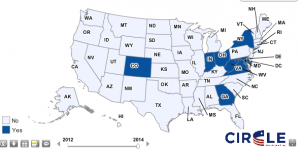- Facebook372
- Total 372
Let’s define “the Left” as thinkers and organizational leaders who are open to voting for Democratic candidates but generally critical of the party, holding more radical policy objectives than elected Democrats do.
The Left has had plenty of reason to criticize the Obama Administration: the president does not fully share its the goals and priorities. I have tended to defend the administration, both because my objectives are closer to the President’s and also because I think he has consistently accomplished more than they have given him credit for. I detect a tendency to overestimate the importance of presidential rhetoric (Obama’s being relatively moderate) while overlooking concrete and tangible victories for poor people. (See, e.g., “Obama Cares. Look at the Numbers” by But the president and his appointees have also at times given unnecessary offense to the Left; and the Left is entitled to be critical of an administration that is not actually Leftist.
Now the Obama Administration has just two years to run, and the overwhelming favorite to lead the Democratic Party is Hillary Clinton. She is her own person and should not be automatically equated with her husband. But I believe that both the Clinton presidency and Hillary Clinton’s own record in the Senate and the State Department suggest that she would stand at least somewhat to the right of Barack Obama. I have therefore always found Clinton nostalgia among members of the Left very strange and discomfiting. You can criticize the current president from the Left, but it seems completely mistaken to prefer his Democratic predecessors, Bill Clinton and Jimmy Carter.
Opinion is beginning to shift. For instance, from 2009 until a few months ago, Paul Krugman was generally a strong critic of the president. I yield to Krugman on all economic matters but argued (e.g., in the Huffington Post, 2010) that his political analysis was off. In any case, it interests me he seems to have revised his estimation. For instance,
- June 15, “Yes He Could: Health Care and Climate: President Obama’s Big Deals“
- July 13, “Obamacare Fails to Fail“
- August 3, “Obama’s Other Success: Dodd-Frank Financial Reform Is Working“
- August 31, “The Medicare Miracle“
One explanation may simply be that more data is in. It was unclear ca. 2010–and seemed unlikely–that the Obama Administration was advancing progressive policy goals, but now we can see that progress was made. In that case, Paul Krugman’s change of tone is the result of having more information.
Meanwhile, we are beginning to see signs that Hillary Clinton will tangle with the Left. According to the Amy Chozick in the New York Times, “Without discussing her 2016 plans, she has talked to friends and donors in business about how to tackle income inequality without alienating businesses or castigating the wealthy. That message would likely be less populist and more pro-growth, less about inversions and more about corporate tax reform, less about raising the minimum wage and more long-term job creation, said two people with firsthand knowledge of the discussions.”
Months ago, Ben White wrote in Politico:
“The darkest secret in the big money world of the Republican coastal elite is that the most palatable alternative to a nominee such as Sen. Ted Cruz of Texas or Sen. Rand Paul of Kentucky would be Clinton, a familiar face on Wall Street following her tenure as a New York senator with relatively moderate views on taxation and financial regulation. … ‘If it turns out to be Jeb versus Hillary we would love that and either outcome would be fine,’ one top Republican-leaning Wall Street lawyer said over lunch in midtown Manhattan last week. ‘We could live with either one. Jeb versus Joe Biden would also be fine. It’s Rand Paul or Ted Cruz versus someone like Elizabeth Warren that would be everybody’s worst nightmare.’ … Most top GOP fundraisers and donors on Wall Street won’t say this kind of thing on the record for fear of heavy blowback from party officials, as well as supporters of Cruz and Rand Paul. Few want to acknowledge publicly that the Democratic front-runner fills them with less dread than some Republican 2016 hopefuls. …
And the Left is beginning to get openly restive. According to Alexandra Jaffe in The Hill, “'[A] Clinton presidency undos [sic] all our progress and returns the financial interests to even more prominence than they currently have,’ Melissa Byrne, an activist with the Occupy Wall Street movement, said in a November 2013 email.” The same article quotes the political consultant Mike Lux, who says, “I also came to know how close she was to the pro-Wall Street forces inside the administration and out, and the downsides on foreign policy are all very real. So I will hesitate for a long time before jumping into her campaign.”
How will the Left respond to the Clinton campaign, especially considering that she is very popular among voters who consider themselves progressive and is the first woman to have a serious shot at the presidency? How will the Left manage if four years of a conservative Democrat follow eight years of a moderate Democrat? And how will the Left describe and use the legacy of Barack Obama in years to come?
I am not interested in these questions because of the potential impact on two individuals, Hillary Clinton and Barack Obama. I am concerned about the condition of the Left as a countervailing force in American politics. The near future will be a difficult time.


